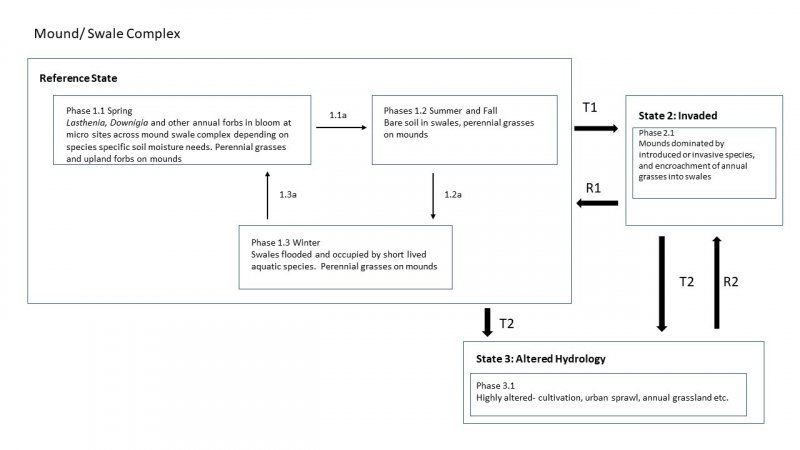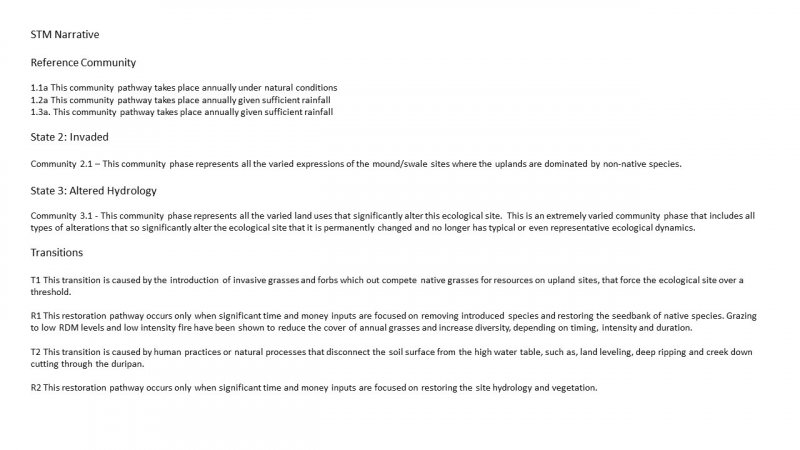Ecological site group R017XY903CAESG
Stream Channels and Floodplains
Last updated: 06/03/2024
Accessed: 12/21/2025
Ecological site group description
Key Characteristics
- Landform Not As Above
- Not As Above
- Site is Sub-Irrigated
- Occasional Flooding (Under Historic Conditions)
Provisional. A provisional ecological site description has undergone quality control and quality assurance review. It contains a working state and transition model and enough information to identify the ecological site.
Physiography
This site is within the bank full channels and floodplains of all river and large streams in the central valley, which includes C, D, E, and F streams on the Level 1 Rosgen Stream Classification.
Climate
The average annual precipitation is 5 to 12 inches (125 to 305 millimeters) in the San Joaquin Valley. The Tulare Basin, at the southern end of this MLRA, typically receives less than 6 inches (150 millimeters) of rainfall per year. The average annual precipitation is 12 to 30 inches (305 to 760 millimeters) in most of the Sacramento Valley. It is 40 inches (1,015 millimeters) at the higher elevations on the edges of the valley at the north end. Summers are long, hot, and dry, and winters are cool and rainy. Most of the rainfall occurs as low- or moderate intensity, Pacific frontal storms from October to May. Snow is very rare in this MLRA but has occurred in the Sacramento Valley from Sacramento to points farther north. The average annual temperature is 59 to 67 degrees F (15 to 20 degrees C), decreasing from south to north. The freeze-free period averages 325 days and ranges from 280 to 365 days, decreasing in length with elevation and from south to north.
Soil features
Soils associated with this site are deep, with course-loamy and courser Family Particle Size Classes. They are predominantly Fluvents, but other Entisols, Inceptisols, Alfisols and Molisols are mapped here.
Some of the soils associated with this ecological site across MLRA 17 are the Columbia, Tujunga, and Grangeville series and the miscellaneous Riverwash component.
Vegetation dynamics
The vegetation dynamics of this site are driven by the scouring of the river channel, deposition of suspended sediment, frequent flooding associated with winter storms and spring runoff from adjacent mountains and access to the river’s seasonally fluctuating water table.
High energy flood events reshape the stream channel and create an exposed gravel site (the amount of disturbance to the site is a function of discharge and slope). The site is colonized by early successional species, most significantly sandbar willow (salix exigua), Goodings willow (salix goodingii) and Fremont cottonwood (Populus fremontii). These plants are dependent upon year-round access to a water table, with a critical part of the growth of cottonwoods happening as the roots extend in response to the lowering of the summer water table. These species are not shade tolerant and require a bare gravel or sand substrate with adequate water to germinate and develop.
If the site is stable for long periods of time the cottonwood will grow tall enough to shade out the willow across the majority of the site creating a cottonwood forest site, or finer sediments will be impounded creating sites suitable for the recruitment of other deciduous trees, including, valley oak (Quercus lobata), California sycamore (Planatus racemose), and box elder (Acer negundo) establishing a mixed riparian forest site (Barbour et al., 2007). Both climax communities are dependent on frequent overbank flooding and access to a water table.
This site has an extensive history of human disturbance going back to the mid 1800s, which includes wood harvesting, agricultural conversion, hydraulic mine spoils, and dredging. Across the MLRA less than 15% of the historic riparian forest remains.
The disturbance with the broadest impact comes from the construction of dams and the regulation of stream flow in both winter and summer, which change the hydrologic factors driving succession on these sites. Winter flows are reduced as water is impounded or diverted so the scour events happen less frequently. Springtime flows, which are important for cottonwood gemination are reduced and summer flows and water tables are higher on regulated channels, which causes problems for cottonwood establishment and recruitment. (CALFED, 1999). Oak recruitment has also been altered but the causes of this are not as well understood.
Groundwater pumping has changed many stream reaches in MLRA 17 from gaining streams, where water flows from the water table into the stream, to losing streams, where water flows from the stream bank into the water table. Because of this change, some water courses with historically perennial streams have changed to intermittent streams (Robertson-Bryan, 2006).
Under these conditions many sites which once would have supported cottonwood are now dominated by coyote brush (Baccharis pilularis) and annual grasses and forbs or remain willow thickets due to a lack of climax vegetation, and mixed riparian forests are showing signs of decadence and an absence of regeneration of key species.
Invasive species can also cause a change in the vegetation dynamics of these riparian sites. Giant reed grass (Arundo donax) is an invasive, rhizomatous, perennial grass which inhabits similar sites to willow and cottonwood and can potentially outcompete them for resources and establish a monoculture. Invasive tree species including saltcedar (Tamarix spp), tree of heaven (Ailanthus altissima) and Russian olive (Elaeagnus angustifolia) have also modified the ecology of these sites.
At this point in time passive restoration is extremely unlikely. Significant input will be required to manage invasive species and restore hydrologic processes across the entire watershed to restore these sites to their historic function.
References/Citations:
Barbour, M., Keeler-Wolf, T., & Schoenherr, A. A. (Eds.). 2007. Terrestrial vegetation of California. Univ of California Press.
CALFED, 1999. Strategic plan for ecosystem restoration program. Draft Pro grammatic EIR/EIS Technical Appendix. Bay-Delta Program. Sacramento, CA.
Robertson-Bryan, I. 2006. Lower Cosumnes River Watershed Assessment". Elk Grove, California: The Nature Conservancy.
Major Land Resource Area
MLRA 017X
Sacramento and San Joaquin Valleys
Subclasses
Stage
Provisional
Click on box and path labels to scroll to the respective text.
Ecosystem states
| T1 | - | Change in Hydrology |
|---|---|---|
| R1 | - | Hydrology Restored |
| T2 | - | Invasive Species |
| R2 | - | Invasive Species Management |
| R4 | - | Major Hydrology and Invasive Species Management |
State 1 submodel, plant communities
Communities 1, 6, 2 and 5 (additional pathways)
Communities 2 and 6 (additional pathways)
| 1.1a | - | Scouring Flood |
|---|---|---|
| 1.1b | - | Community succession |
| 1.2a | - | Vegetation recruitment |
| 1.3a | - | Community succession |
| 1.3b | - | Scouring Flood |
| 1.3c | - | Community succession |
| 1.4a | - | Scouring Flood |
| 1.4b | - | Community Succession |
| 1.5a | - | Scouring Flood |
| 1.6a | - | Scouring Flood |
| 2.1a | - | Scouring Flood |
|---|---|---|
| 2.2a | - | Vegetation Recruitment and Succession |

